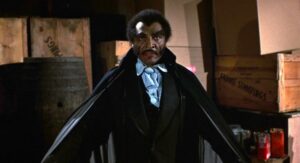A plea for justice and liberation quickly descends into a curse of eternal hunger and isolation.
Blacula bridges gothic horror and the blaxploitation era, placing race, history, and identity into a genre that rarely reflected Black experiences on screen. Blending supernatural horror, melodrama, and social commentary, the film delivers a uniquely stylized entry in the vampire canon, one that is both entertaining and historically significant within Black cinema.
Directed by William Crain, with a screenplay by Raymond Koenig and Joan Torres, the film introduces audiences to Mamuwalde, an 18th-century African prince portrayed with commanding gravitas by William Marshall. When Mamuwalde seeks Count Dracula’s assistance in suppressing the slave trade, he is met not with solidarity but cruelty. Dracula refuses, mocks him, and imposes a curse. Mamuwalde is bitten, renamed “Blacula,” and sealed in a coffin. Nearly two centuries later, Los Angeles antique dealers unwittingly unleash him, setting off a series of bloody encounters that merge classic vampire mythology with the urban energy of 1970s America.
William Marshall’s performance as Mamuwalde is the film’s beating heart. Unlike many horror villains of the era, Mamuwalde is not simply a monster but a tragic figure. His presence commands the screen, his rich baritone voice and regal bearing elevating the character far beyond campiness. While cursed with vampirism, he is also a victim, robbed of his name, his dignity, and his love. Marshall infuses Mamuwalde with both menace and humanity, making him the first on-screen Black vampire of note and establishing Blacula as a cornerstone of horror history. Opposite him, Thalmus Rasulala plays Dr. Gordon Thomas, a figure of rationality and skepticism who investigates the murders soon tied to Mamuwalde. His role functions as a counterbalance, protective of his community, analytical in his approach, and central to uncovering the truth behind the vampire’s presence. Their dynamic underscores the film’s central tension: between rational explanation and supernatural horror, between protector and predator, and between the living and the cursed.
Blacula thrives not only as a horror film but as commentary. The themes of racism, cultural erasure, and exploitation run throughout the narrative. Mamuwalde’s curse originates from a refusal to confront the horrors of slavery, and his suffering echoes through the centuries. The film situates vampirism as both a literal and symbolic form of oppression, asking audiences to consider how history haunts the present.
Visually, Blacula captures the feel of its era. The cinematography embraces warm tones and sharp contrasts, pairing shadowy gothic atmospheres with the vibrancy of Los Angeles nightlife. The soundtrack, infused with funk and soul, lends the film a cultural specificity that separates it from traditional horror of the time, grounding its vampire story in the rhythms of Black expression. The choice to situate horror within contemporary Black spaces gives the film a unique aesthetic, one that both embraces genre tropes and reinvents them.
The film’s legacy is undeniable. While some of its blaxploitation stylings now appear dated, its influence within both the horror and Black film canon is immense. It opened the door for more diverse representation in horror and gave audiences a charismatic Black lead in a genre that often sidelines or stereotypes Black characters. Its cult status has endured not simply for its camp appeal but because of the richness William Marshall brought to his role and the significance of its themes. Stylish, socially aware, and anchored by a performance of regal tragedy, it delivers both thrills and resonance. For those who view horror as a mirror of society, Blacula remains worth revisiting, not just as a cult classic, but as a landmark in telling stories that confront the legacy of racism within the language of horror.



